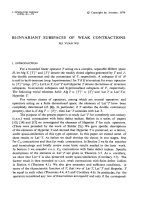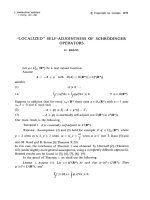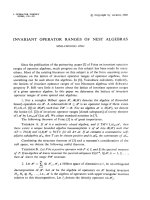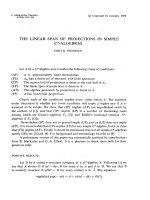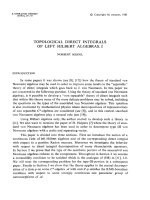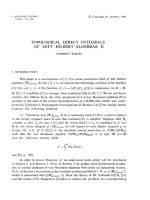Báo cáo toán học: "he spectral radius of subgraphs of regular graphs" ppt
Bạn đang xem bản rút gọn của tài liệu. Xem và tải ngay bản đầy đủ của tài liệu tại đây (77.78 KB, 4 trang )
The spectral radius of subgraphs of regular graphs
Vladimir Nikiforov
Department of Mathematical Sciences, University of Memphis,
Memphis TN 38152, USA
Submitted: May 25, 2007; Accepted: Sep 30, 2007; Published: Oct 5, 2007
Mathematics Subject Classification: 05C50
Abstract
Let µ (G) and µ
min
(G) be the largest and smallest eigenvalues of the adjacency
matrix of a graph G. Our main results are:
(i) Let G be a regular graph of order n and finite diameter D. If H is a proper
subgraph of G, then
µ (G) − µ (H) >
1
nD
.
(ii) If G is a regular nonbipartite graph of order n and finite diameter D, then
µ (G) + µ
min
(G) >
1
nD
.
Keywords: smallest eigenvalue, largest eigenvalue, diameter, connected graph,
nonbipartite graph
Main results
Our notation follows [1]. Specifically, µ (G) and µ
min
(G) stand for the largest and smallest
eigenvalues of the adjacency matrix of a graph G.
The aim of this note is to improve some recent results on eigenvalues of subgraphs of
regular graphs. Cioab˘a ([2], Corollary 2.2) showed that if G is a regular graph of order n
and e is an edge of G such that G − e is a connected graph of diameter D, then
µ (G) − µ (G − e) >
1
nD
.
The approach of [3] helps improve this assertion in a natural way:
Theorem 1 Let G be a regular graph of order n and finite diameter D. If H is a proper
subgraph of G, then
µ (G) − µ (H) >
1
nD
. (1)
the electronic journal of combinatorics 14 (2007), #N20 1
Since µ (H) ≤ µ (H
) whenever H ⊂ H
, we may assume that H is a maximal proper
subgraph of G, that is to say, V (H) = V (G) and H differs from G in a single edge. Thus,
we can deduce Theorem 1 from the following assertion.
Theorem 2 Let G be a regular graph of order n and finite diameter D. If uv is an edge
of G, then
µ (G) − µ (G − uv) >
1/ (nD) , if G − uv is connected;
1/ (n − 3) (D − 1) , otherwise.
.
Furthermore, Theorem 1 implies a result about nonbipartite graphs.
Theorem 3 If G is a regular nonbipartite graph of order n and finite diameter D, then
µ (G) + µ
min
(G) >
1
nD
.
Finally, we note the following more general version of the lower bound in Corollary
2.2 in [2].
Lemma 4 Let G be a connected regular graph and e be an edge of G. If H is a component
of G − e with µ (H) = µ (G − e) , then
µ (G) − µ (H) >
1
Diam (H) |H|
.
This lemma follows easily from Theorem 2.1 of [2] and its proof is omitted.
Proofs
Proof of Theorem 2 Write dist
F
(s, t) for the length of a shortest path joining two
vertices s and t in a graph F. Write d for the degree of G, let H = G − uv, and set
µ = µ (H).
Case (a): H is connected.
Let x = (x
1
, . . . , x
n
) be a unit eigenvector to µ and let x
w
be a maximal entry of x;
we thus have x
2
w
≥ 1/n. We can assume that w = v and w = u. Indeed, if w = v, we see
that
µx
v
=
vi∈E(G)
x
i
≤ (d − 1) x
v
,
and so d − µ ≥ 1, implying (1). We have
d − µ = d
i∈V (G)
x
2
i
− 2
ij∈E(G)
x
i
x
j
=
ij∈E(G)
(x
i
− x
j
)
2
+ x
2
u
+ x
2
v
.
the electronic journal of combinatorics 14 (2007), #N20 2
Assume first that dist
H
(w, u) ≤ D − 1. Select a shortest path u = u
1
, . . . , u
k
= w
joining u to w in H. We see that
d − µ =
ij∈E(G)
(x
i
− x
j
)
2
+ x
2
u
+ x
2
v
>
k−1
i=1
x
u
i
− x
u
i+1
2
+ x
2
u
≥
1
k − 1
x
u
i
− x
u
i+1
2
+ x
2
u
=
1
k − 1
(x
w
− x
u
)
2
+ x
2
u
≥
1
k
x
2
w
≥
1
nD
,
completing the proof.
Hereafter, we assume that dist
H
(w, u) ≥ D and, by symmetry, dist
H
(w, v) ≥ D.
Let P (u, w) and P (v, w) be shortest paths joining u and v to w in G. If u ∈ P (v, w) ,
then there exists a path of length at most D − 1, joining w to u in G, and thus in H, a
contradiction. Hence, u /∈ P (v, w) and, by symmetry, v /∈ P (u, w) . Therefore, the paths
P (u, w) and P (v, w) belong to H, and we have
dist
H
(w, u) = dist
H
(w, v) = D.
Let Q (u, z) and Q (v, z) be the longest subpaths of P (u, w) and P (v, w) having no
internal vertices in common. Clearly Q (u, z) and Q (v, z) have the same length. Write
Q (z, w) for the subpath of P (u, w) joining z to w and let
Q (u, z) = u
1
, . . . , u
k
, Q (v, z) = v
1
, . . . , v
k
, Q (z, w) = w
1
, . . . , w
l
,
where
u
1
= u, u
k
= v
k
= w
1
= z, w
l
= w, k + l − 2 = D.
The following argument is borrowed from [2]. Using the AM-QM inequality, we see that
d − µ ≥
k−1
i=1
x
v
i
− x
v
i+1
2
+ x
2
v
+
k−1
i=1
x
u
i
− x
u
i+1
2
+ x
2
u
+
l−1
i=1
x
w
i
− x
w
i+1
2
≥
2
D − l + 2
x
2
z
+
1
l − 1
(x
w
− x
z
)
2
≥
2
D + l − 1
x
2
w
≥
1
Dn
,
completing the proof.
Case (b): H is disconnected.
Since G is connected, H is union of two connected graphs H
1
and H
2
such that u ∈ H
1
,
v ∈ H
2
. Assume µ = µ (H
1
) , set |H
1
| = k and let x = (x
1
, . . . , x
k
) be a unit eigenvector
to µ. Since d ≥ 2, we see that |H
2
| ≥ 3, and so, k ≤ n − 3.
Let x
w
be a maximal entry of x; we thus have x
2
w
≥ 1/k ≥ 1/ (n − 3) . Like in
the previous case, we see that w = u. Since d ≥ 2, there is a vertex z ∈ H
2
such
that z = v. Select a shortest path u = u
1
, u
2
, . . . , u
l
= w joining u to w in H
1
. Since
dist
G
(z, w) ≤ diam G = D, we see that l ≤ D − 1. As above, we have
d − µ =
ij∈E(G)
(x
i
− x
j
)
2
+ x
2
u
+ x
2
v
>
l−1
i=1
x
u
i
− x
u
i+1
2
+ x
2
u
≥
1
l − 1
(x
u
1
− x
u
k
)
2
+ x
2
u
=
1
l − 1
(x
w
− x
u
)
2
+ x
2
u
≥
1
l
x
2
w
≥
1
(n − 3) (D − 1)
,
the electronic journal of combinatorics 14 (2007), #N20 3
completing the proof. ✷
Proof of Theorem 3 Let x = (x
1
, . . . , x
n
) be an eigenvector to µ
min
(G) and let U =
{u : x
u
< 0} . Write H for the bipartite subgraph of G containing all edges with exactly
one vertex in U; note that H is a proper subgraph of G and µ
min
(H) < µ
min
(G) . Hence,
µ (G) + µ
min
(G) > µ (G) + µ
min
(H) = µ (G) − µ (H) ,
and the assertion follows from Theorem 1. ✷
Acknowledgment A remark of Lingsheng Shi initiated the present note and a friendly
referee helped complete it.
References
[1] B. Bollob´as, Modern Graph Theory, Graduate Texts in Mathematics, 184, Springer-
Verlag, New York (1998), xiv+394 pp.
[2] S. M. Cioab˘a, The spectral radius and the maximum degree of irregular graphs, Elec-
tronic J. Combin., 14 (2007), R38.
[3] V. Nikiforov, Revisiting two classical results on graph spectra, Electronic J. Combin.,
14 (2007), R14.
the electronic journal of combinatorics 14 (2007), #N20 4
